brakes GMC JIMMY 1997 Owner's Manual
[x] Cancel search | Manufacturer: GMC, Model Year: 1997, Model line: JIMMY, Model: GMC JIMMY 1997Pages: 410, PDF Size: 20.03 MB
Page 10 of 410
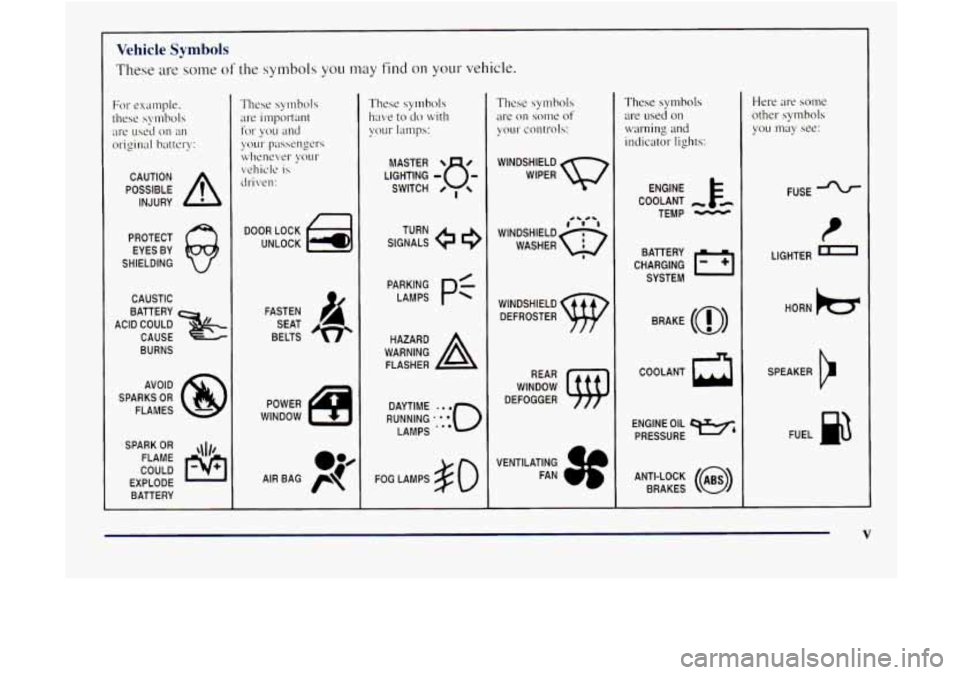
~~~~ Vehicle Symbols
These are some of the symbols you may find on your vehicle.
POSSIBLE A
CAUTION
INJURY
PROTECT EYES BY
SHIELDING
CAUSTIC
ACID COULD
&
BATTERY
CAUSE
BURNS
AVOID
SPARKS
OR
FLAMES
SPARK
OR ,\I/,
COULD FLAME
EXPLODE BATTERY
DOOR LOCK
UNLOCK
FASTEN SEAT
BELTS
POWER
WINDOW SIGNALS
e
TURN
RUNNING
.':o'o
DAYTIME LAMPS
..e
FOG LAMPS $0
These symbols
are on some of
your controls:
WINDSHIELD
WIPER
WINDSHIELD DEFROSTER
VENTILATING FAN
These symbols
are
used 011
warning and
indicator lights:
COOLANT
TEMP
CHARGING I-1
BAllERY
SYSTEM
BRAKE
(@)
COOLANT a
ENGINE OIL e,
PRESSURE
ANTI-LOCK
(@)
BRAKES
Here are some
other symbols
YOLI may see:
FUSE
t
LIGHTER m
HORN k3
SPEAKER
b
FUEL I&
V
Page 80 of 410
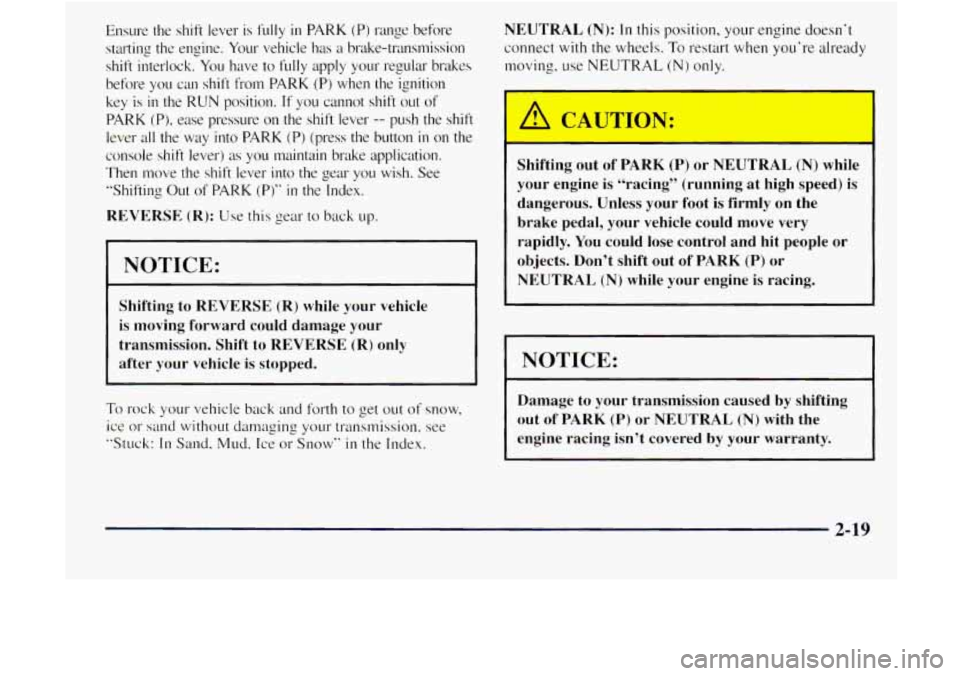
E11~~11-e the shift lever is f~~lly in PARK (P) range before
starting
the engine. Your vehicle has a brake-transmission
shift interlock. You have to
fully apply your regular brakes
before
you can shift from PARK (P) when the ignition
key is
in the RUN position. If you cannot shift out of
PARK (P), ease pressure on the shift lever -- push the shift
lever all
the way into PARK (P) (press the button in on the
console shift lever)
as you maintain brake application.
Then n~ove the
shift lever into the gear you wish. See
“Shifting Out of PARK
(P)“ in the Index.
REVERSE (R): Use
this gear to back up.
NOTICE:
Shifting to REVERSE (R) while your vehicle
is moving forward could damage your
transmission. Shift
to REVERSE (R) only
after your vehicle
is stopped.
To rock yo~~r vehicle back and forth to get out of snow.
ice or
sand without damaging your transmission, see
”Stuck:
In Sand, Mud. Ice or Snow“ in the Index. NEUTRAL
(N): In this position, your engine doesn’t
connect
with the wheels. To restart when you’re already
moving. use NEUTRAL
(N) only.
Shifting out of PARK
(P) or NEUTRAL (N) while
your engine is “racing” (running at high speed)
is
dangerous. Unless your foot is firmly on the
brake pedal, your vehicle could move very
rapidly. You could lose control and hit people or
ob-jects. Don’t shift out of PARK
(P) or
NEUTRAL (N) while your engine is racing.
I NOTICE:
Damage to your transmission caused by shifting
out of PARK
(P) or NEUTRAL (N) with the
engine racing isn’t covered by your warranty.
2-19
Page 81 of 410
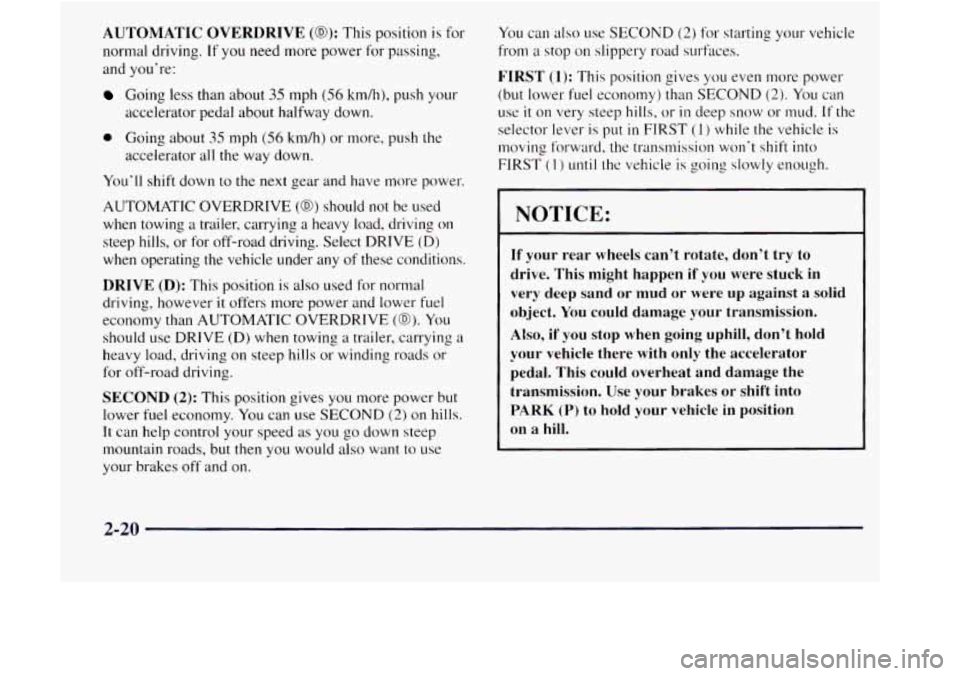
AUTOMATIC OVERDRIVE (a): This position is for
normal driving.
If you need more power for passing,
and you’re:
Going less than about 35 mph (56 km/h), push your
accelerator pedal about halfway down.
0 Going about 35 mph (56 kdh) or more, push the
accelerator all the way down.
You’ll shift down to the next gear and have more power.
AUTOMATIC OVERDRIVE
(@) should not be used
when towing
a trailer, carrying a heavy load. driving on
steep hills, or for off-road driving. Select DRIVE
(D)
when operating the vehicle under any of these conditions.
DRIVE (D): This position is also used for normal
driving, however
it offers Inore power and lower fuel
economy than AUTOMATIC OVERDRIVE
(@). You
should use DRIVE (D) when towing a trailer, carrying a
heavy load, driving on steep hills or winding roads or
for off-road driving.
SECOND (2): This position gives you more power but
lower
fuel economy. You can use SECOND (2) on hills.
It can help control your speed as you go down steep
mountain roads, but then you would also want to use
your brakes off and on. You
can
also LIS~ SECOND (2) for starting your vehicle
from
a stop on slippery road surfaces.
FIRST (1): This position gives you even more power
(but lower fuel economy) than
SECOND (2). You can
use
it on very steep hills, or in deep snow or mud. If the
selector lever
is put in FIRST (1) while the vehicle is
moving forward. the transmission won’t shift into
FIRST
( I) until thc vehicle is going slowly enough.
NOTICE:
If your rear wheels can’t rotate, don’t try to
drive. This might happen if you were stuck in
very deep sand or mud or were up against a solid
object. You could damage your transmission.
Also, if you stop when going uphill, don’t hold
your vehicle there with only the accelerator
pedal. This could overheat and damage the
transmission. Use your brakes or shift into
PARK (P) to hold your vehicle in position
on a
hill.
2-20
Page 86 of 410
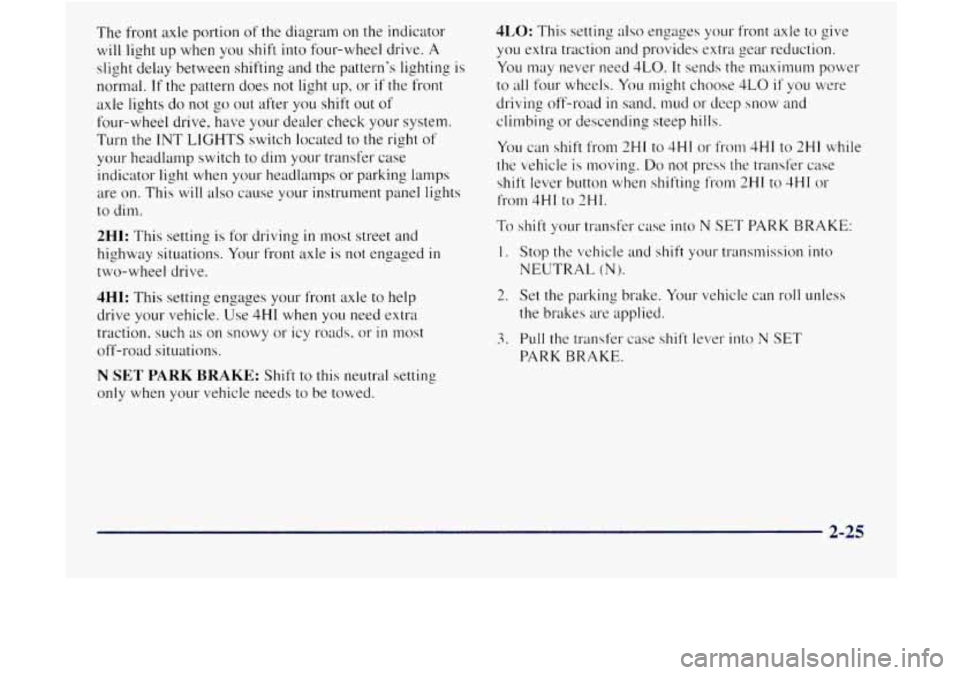
The front axle portion of the diagram on the indicator
will light up when you shift
into four-wheel drive. A
slight delay between shifting and the pattern's lighting is
normal. If the pattern does not light up, or if the front
axle lights
do not go out after you shift out of
four-wheel drive, have your dealer check your system.
Turn
the INT LIGHTS switch located to the right of
your headlamp switch to dim your transfer case
indicator light when your headlamps or parking lamps
are on. This
will also cause your instrument p.anel lights
to dim.
2HI: This setting is for driving in most street and
highway situat.ions. Your front axle
is not engaged in
two-wheel drive.
4HI: This setting engages your front axle to help
drive
your vehicle. Use 4H1 when you need extra
traction. such
as on snowy or icy roads. or in most
off-road situations.
N SET PARK BRAKE: Shift to this neutral setting
only when your vehicle needs to be towed.
4LO: This setting also engages your front axle to give
you extra traction and provides extra gear reduction.
YOLI may never need 4LO. It sends the maximum power
to all four wheels. You might choose 4L0 if you were
driving off-road
in sand, mud or deep snow and
climbing or descending steep hills.
You can shift from
2HI to 4H1 or from 4HI to 2HI while
the vehicle
is moving. Do not press the transfer case
shift lever button when shifting from
2HI to ;CHI or
from
4HI to 2HI.
To shift your transfer case into N SET PARK BRAKE:
1. Stop the vehicle and shift your transmission into
NEUTRAL
(N).
2. Set the parking brake. Your vehicle can roll unless
the brakes are applied.
3. Pull the transfer case shift lever into N SET
PARK BRAKE.
2-25
Page 90 of 410
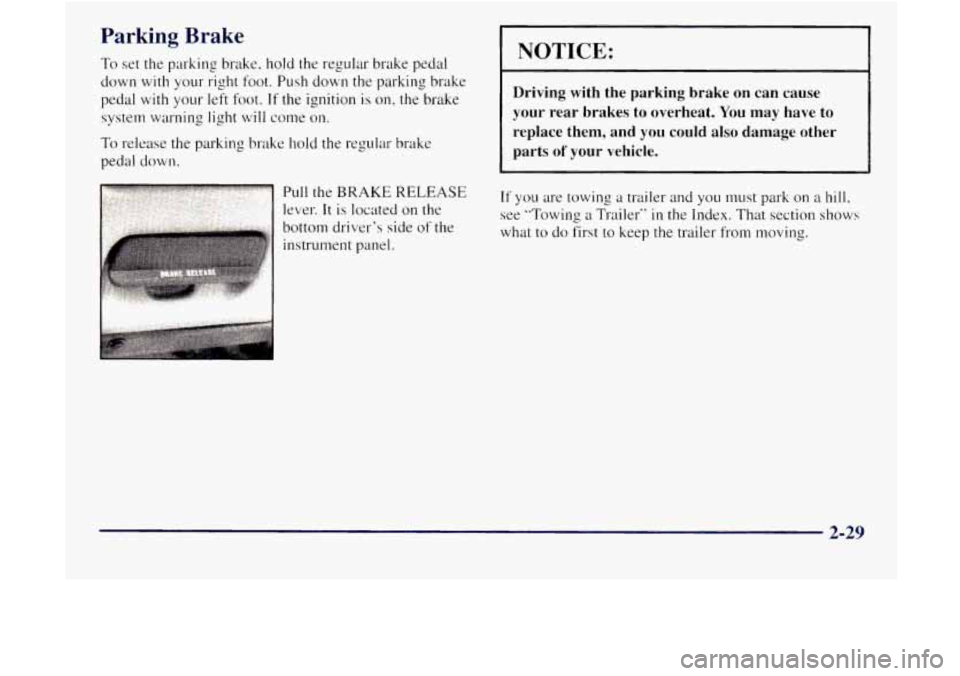
Parking Brake
To set the parking brake. hold the regular brake pedal
down with your right foot. Push down the parking brake
pedal with your left
foot. If the ignition is on, the brake
system warning light
will come on.
To
release the parking brake hold the regular brake
pedal
down.
NOTICE:
Driving with the parking brake on can cause
your rear brakes to overheat. You
may have to
replace them, and you could also damage other
parts
of your vehicle.
If you are towing a trailer and you must park on a hill,
see "Towing a Trailer" in the Index. That section shows
what to
do first to keep the trailer from moving.
2-29
Page 103 of 410
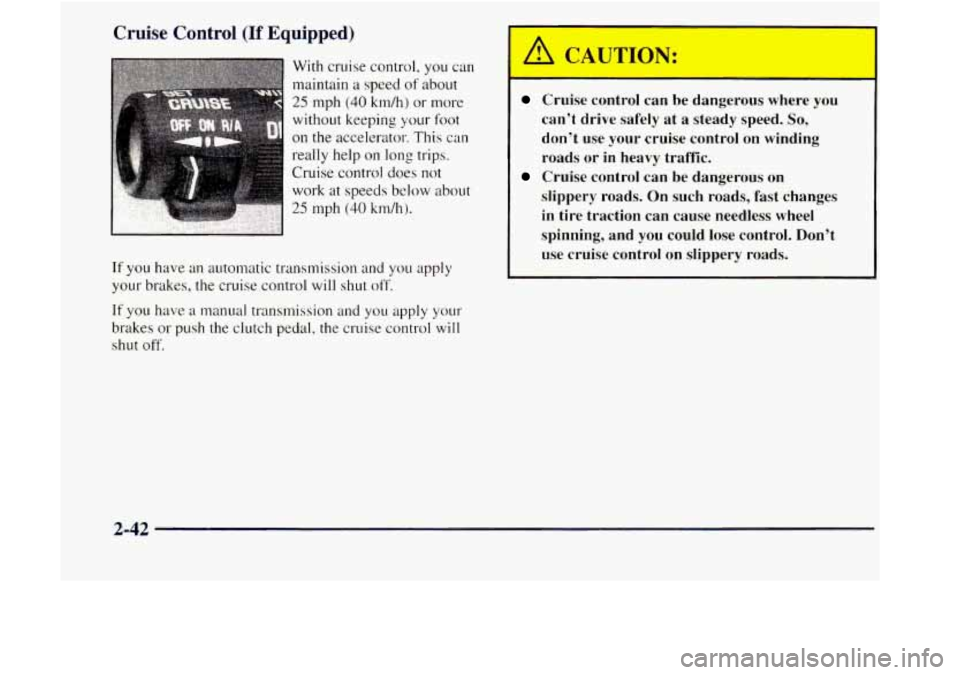
Cruise Control (If Equipped)
With cruise control, you can
maintain
a speed of about
25 mph (40 krn/h) or more
without keeping your foot
on the accelerator. This
can
really help on long trips.
Cruise control
does not
work at speeds below about
25 rnph (40 km/h).
If you have an automatic transmission and you apply
your brakes, the cruise control will shut
off.
If you have a manual transmission and you apply your
brakes or push the clutch pedal, the cruise control
will
shut off.
A CAUi ION:
I
Cruise control can be dangerous where you
can’t drive safely at
a steady speed. So,
don‘t use your cruise control on winding
roads or in heavy traffic.
slippery roads. On such roads, fast changes
in tire traction can cause needless wheel
spinning, and you could lose control. Don’t
use cruise control on slippery roads.
Cruise control can be dangerous on
Page 171 of 410

Control of a Vehicle
You have three systems that make your vehicle go where
you want
it to go. They are the brakes, the steering and
the accelerator. All three systems have to do their work
at the places where the tires meet the road.
Sometimes, as when you’re driving on snow or ice, it’s
easy to ask more
of those control systems than the tires
and road can provide. That means you can lose control
of your vehicle.
Braking
Braking action involves perception time and
reaction time.
First, you have to decide to push on the brake pedal.
That’s
perception time. Then you have to bring up your
foot and do it. That’s
reaction time.
Average reaction time is about 314 of a second. But
that’s only an average. It might be less with one driver
and as long as two or three seconds or more with
another. Age, physical condition, alertness, coordination
and eyesight all play a part.
So do alcohol, drugs and
frustration. But even in
314 of a second, a vehicle
moving at
60 mph (100 km/h) travels 66 feet (20 m).
That could be a lot of distance in an emergency,
so
keeping enough space between your vehicle and others
is important.
And, of course, actual stopping distances vary greatly
with the surface of the road (whether it’s pavement or
gravel); the condition of the road (wet, dry, icy); tire
tread; the condition of your brakes; the weight
of the
vehicle and the amount of brake force applied.
Page 172 of 410
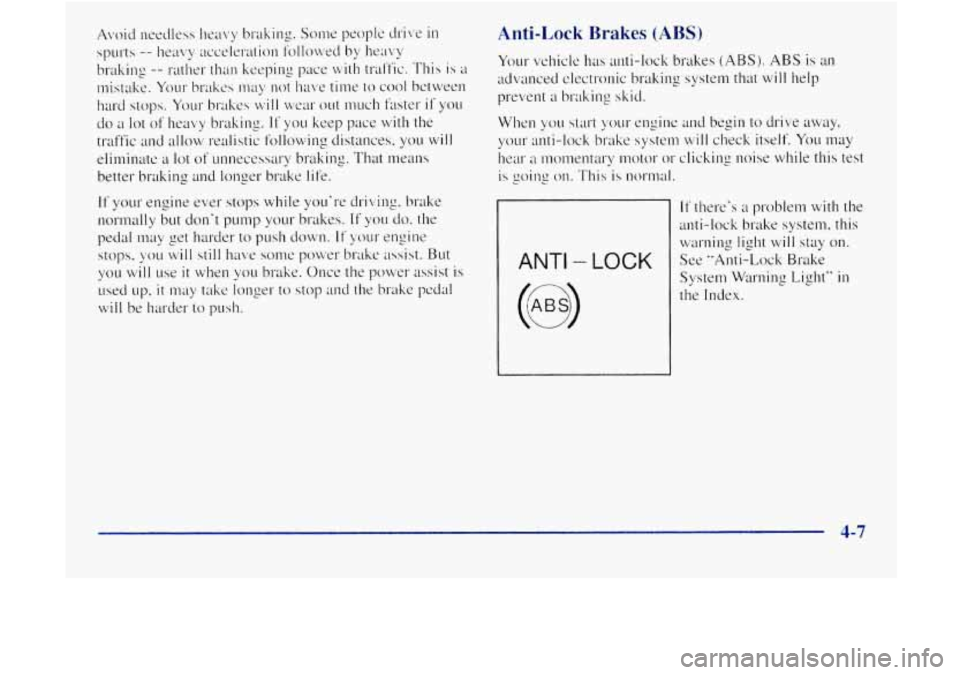
Anti-Lock Brakes (ABS)
If there’s ;1 problem with the
anti-lock
brake system. this
warning light
will stay on.
See “Anti-Lock Brake
System Warning Light”
in
the Index.
4-7
Page 173 of 410

The anti-lock system can change the brake pressure
faster
than any driver could. The computer is
programmed to make the most of available tire and
road conditions. I
Here’s how anti-lock works. Let’s say the road is wet.
You‘re driving safely. Suddenly
an animal jumps out in
front of you.
You slam
on the brakes. Here’s what happens with ABS.
A computer senses that wheels are slowing down. If one
of the wheels is about to stop rolling, the computer will
separately work the brakes at each front wheel and at the
rear wheels. You
can steer
around the obstacle while braking hard.
As you brake. your colnputer keeps receiving updates on
wheel speed and controls braking pressure accordingly.
4-8
Page 178 of 410

0 Check your mirrors. glat~ce over your shoulder and
start your left lane change signal before moving out
of the right lane to pass. When you are
far enough
ahead
of the passed vehicle to see its front in yo~~r
inside mirror. acti\;ate your right lane change signal
and move
back into the right lane. (Remember that
your right outside mirror is convex. The vehicle you
just passed
may seem to be farther away f'rom you
than it really is.)
a Try not to pass more than one vehicle at a time on
two-lane roads. Reconsider before passing the
next vehicle.
Loss of Control
Let's re\:iew what driving experts say about what
happens when the three control systems
(brakes. steering
;MI accelerution) don't ha\^ enough friction where the
tires meet the road
to do what the driver has asked.
In any emergency. don't give up. Keep trying to steer a.nd
constantly seek an escape route
or area of less danger.
Skidding
4-13